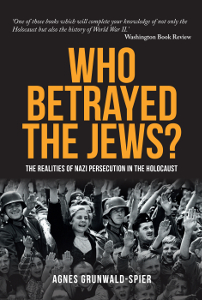When I was writing about Holocaust Rescuers I was overwhelmed by the courage and generosity of spirit of the rescuers. However, there was one person who really shocked me and that was a Belgian traitor called Prosper de Zitter who betrayed members of the resistance and allied airmen trying to get home. I wondered how he could deliberately lead someone into a Gestapo trap knowing he was leading them to their probable death. I began to ponder the meaning of betrayal and treachery.
I thought about my maternal grandfather, Armin Klein, who refused to leave Hungary. He asked my Mother: ‘Why should I leave my native land?’ He had a misplaced faith that his native land would be safe. The answer which only came later – was that ‘you are a Jew and you will die in Auschwitz in 1944 without even a chance to know your fate and say goodbye to your family. You will die around the time your first grandchild is born – the birth you were so excited about.’ Armin was sitting on a bus in Budapest in mid-1944 when it was stopped and all the Jews were taken off and sent to Auschwitz, where he is believed to have died almost immediately
As I, that first grandchild, investigated the field I was shocked by what I found. I have lived with the Holocaust all my life, 70 years, but I was unaware of the economic aspects of the Holocaust. An exhibition organised by the Leipzig City Museum in 2009 was entitled “‘Aryanization’ in Leipzig. Driven out. Robbed. Murdered”. How true that was because the Jews were robbed before they were killed and the variety of ways devised by the Nazis to do this were numerous and innovative.
This book is not intended to be, nor can it be, a comprehensive narrative of the Holocaust. Its almost a scrapbook of the Holocaust. Its intention is to give readers an insight into the horrors of the Holocaust – by looking at the different forms of betrayal that took place – how the noose was tightened round the neck of the poor trapped Jews. The physical and economic strangulation took place over the years and finally those that survived to get to the camps were de-personalized and starved, tortured and worked to death.
There is no shortage of information and I was snowed under with it all. However some people even, at this late stage chose not to divulge their stories which is sad because if not recorded, they will be lost – less ammunition against the Holocaust deniers. Some stories I received were very brief – from child survivors who knew very little. A lifetime’s tragedy in half a sentence – and no one else left to ask. My friend Renée Fink from America told me ‘My parents were hiding in Holland and were betrayed’. The only information she had was that they were living on a boat on the Loosdrechtse Plasse in 1942. Their names were Edit and Fritz Laser and they had come to Holland from Germany in 1933. 1 Fritz was born in Königsberg on 30 May 1896 and Edit in Breslau on 15 July 1911. Edith was sent to Auschwitz via Westerbork where she was killed on 19 May 1943 aged 32. Fritz died on 31 March 1944 but the town where he died is not known.2 Fortunately they were farsighted and brave enough to hand their precious daughter over to the Dutch Underground. ‘I was placed with a Catholic family of eight children (I made the ninth). They took me for the duration of the war, sharing what little they had with me and endangering every one of them each and every day for hiding me. I loved them all and wanted to stay. And you know, I’m sure they would have continued to make a home for me.’3
I am not an academic. I am at 71 one of the youngest Holocaust survivors. I embarked on this book because I am horrified by what I see around me today – those that deny the Holocaust ever happened or those that denigrate what it actually was; those who have no idea of the intricacies of its conception or implementation. I was first awoken to this detail in the 1990s by my dear mentor, Professor Aubrey Newman, who spoke at a conference about men in suits looking at plans for the crematoria and calculating the throughput to be processed per day. Not counting boxes of baked beans nor packets of rice, but gassed Jews whose bodies were to be burnt leaving only the ashes of whole communities. This book is meant for those that compare the Holocaust to relatively trivial events, which bear no comparison – because no other genocide bears comparison.
Agnes Grunwald-Spier
December 2015.
1 Renée Fink, e mails to author 3 and 4 January 2013.
2 Dutch Jewish records, accessed 24 March 2014, http://www.joodsmonument.nl/person/473082/en?lang=en
3 Renee Fink, e mail to author, 23 March 2014.
